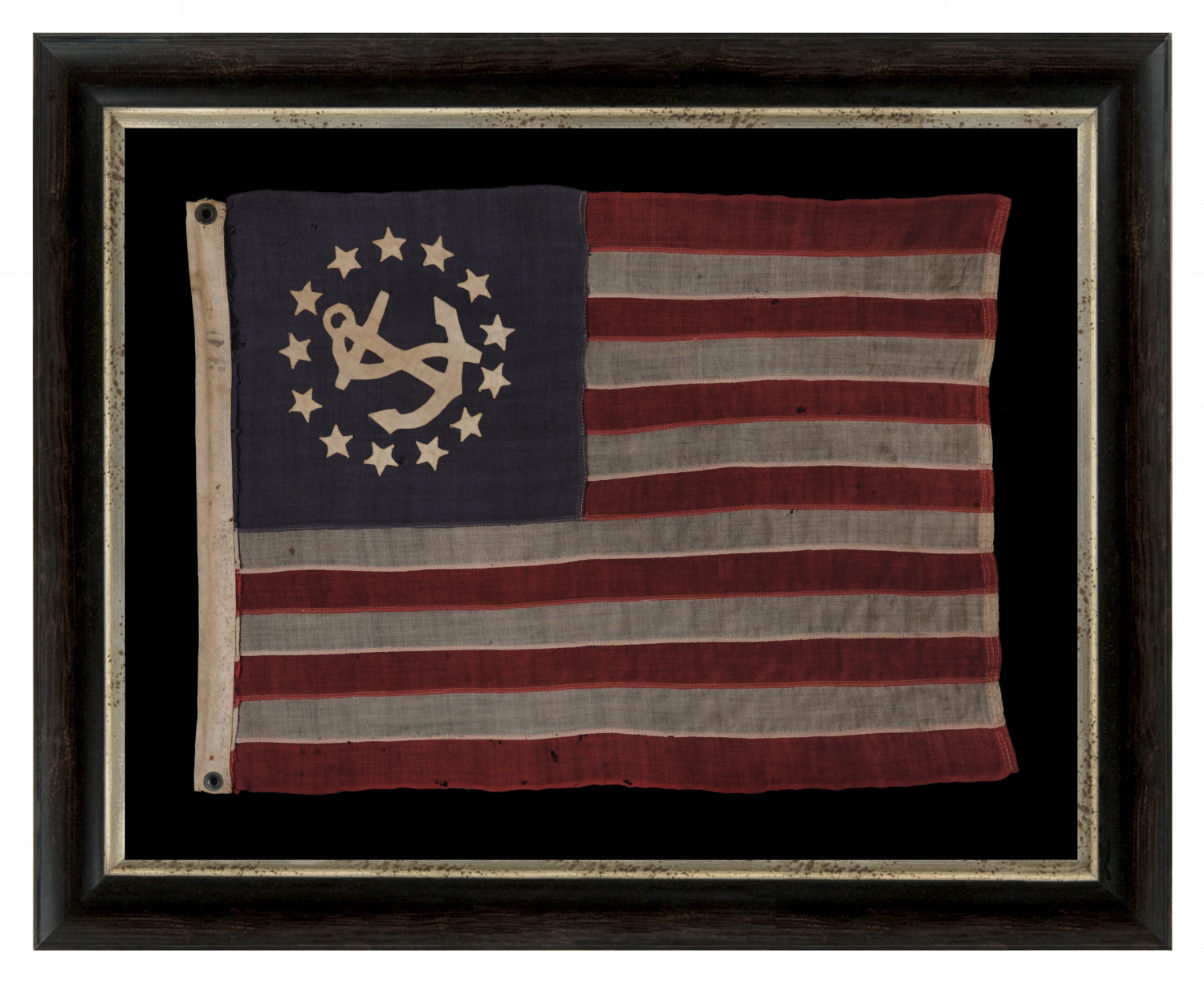
| |
13 STAR PRIVATE YACHT ENSIGN, THE SMALLEST EXAMPLE THAT I HAVE EVER ENCOUNTERED WITH HAND-SEWN STARS AND A CANTED ANCHOR, 1885-1895 |
|
| Available: |
Sold |
| Frame Size (H x L): |
33.5" x 41.5" |
| Flag Size (H x L): |
21.75"x 29" |
|
| Description....: |
|
The medallion configuration, 13-star, 13-stripe flag with a canted center anchor was entered into official use in 1848, following an act of Congress, that made it the official signal for U.S. pleasure sailing vessels. The need for such a flag arose with the popularity of boating as a pastime for well-to-do Americans, and as a competitive sport, in addition to its longstanding utilitarian role as a vehicle of trade. In early America, all boats were subject to customs searches at every port. Without modern income tax, the federal government derived its revenues mostly from tariffs, so an accounting of foreign goods on ships was a critical venture. As yachting for pleasure became more prevalent, however, more and more time was spent searching boats that had no such inventory, wasting time for both customs officials and wealthy ship owners.
John Cox Stevens (1775 - 1857), one of the most important members of New York society, was responsible for bringing this flag to fruition. Stevens was the paternal grandson of John Stevens Jr., New Jersey delegate to the Second Continental Congress, and the son of Revolutionary War officer, Colonel John Stevens, a pioneer in the development of steamboats and purchaser of what is now the City of Hoboken. Among other ventures, John Cox Stevens served as president of the Jockey Club (United Kingdom), was a founding member and 2nd president of New York's Union Club (est. 1836), and founding Commandant of the New York Yacht Club (elected 1844/est. 1845). He was part of the syndicate that own the yacht "America," which, in 1851, won the trophy that would eventually be named in its honor, the America's Cup.
In 1847, Stevens approached the secretary of the treasury and suggested that something be done to streamline the customs process for non-trade vessels. In 1848, legislation passed Congress requiring registration of these boats, which could then fly the “American Yachting Signal” to bypass customs. This remained on the books until the 1980’s. Though the 1848 legislation was revoked, flags in this design, flown for decorative function, continues to this day.
Made sometime between 1885 and 1895, this is among the earliest private yacht ensigns that exist in modern day America. Despite being an early design, very few survive that date to the 19th century and extremely few are known that have hand-sewn elements, like this flag.
Measuring just 30 inches on the fly, this is the smallest flag that I have ever seen in this design that has hand-sewn stars and a hand-sewn anchor. It is, in fact, among the smallest wool flags I have ever seen that date to this period. The small size is a very desirable trait. Prior to the 1890’s, most flags made for extended outdoor use were very large. Those with sewn construction were generally eight feet long and larger. This is because flags needed to be seen from a distance to be effective in their purpose as signals, while today their use is more often decorative and the general display of patriotism. Because 19th century sewn flags can be cumbersome to frame and display in an indoor setting, many collectors prefer small examples, like this one.
Also note the nice visual qualities, which include a light blue canton and especially small stars in proportion to the anchor they encircle. The medallion is smaller than usual, with plenty of open space on each side.
Construction: The stars and anchor are made of cotton, hand-sewn, and are double-appliquéd. This means that they are applied to both sides. The canton and the stripes of the flag are made of wool bunting that has been pieced with treadle stitching. There is a twill cotton header with two brass grommets, along which “30” is stenciled in black ink to indicate length in inches. "X 22" was added with a dip pen to indicate the hoist measurement.
Mounting: The flag was mounted and framed within our own conservation department, which is led by expert staff. We take great care in the mounting and preservation of flags and have framed thousands of examples.
The background fabric is 100% cotton twill, black in color. The black-painted, hand-gilded and distressed molding is Italian and is of extraordinary quality, with a wide, ogee profile. The glazing is U.V. protective acrylic. Feel free to contact us for more details.
Condition: There is separation of the canton from the top of the hoist running about 5.5 inches with some associated fabric loss. There is very minor mothing throughout. The canton has faded to a dusty blue color. There is moderate foxing and staining on the hoist binding. |
|
|
|
| Collector Level: |
Advanced Collectors and the Person with Everything |
|
| Flag Type: |
Sewn flag |
|
| Star Count: |
13 |
|
| Earliest Date of Origin: |
1885 |
|
| Latest Date of Origin: |
1895 |
|
| State/Affiliation: |
13 Original Colonies |
|
| War Association: |
|
|
| Price: |
SOLD |
|
| |
Views: 1415 |
|
|
|

